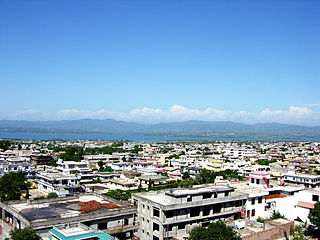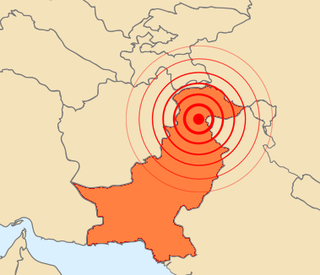
Azad Jammu and Kashmir, abbreviated as AJK and colloquially referred to as simply Azad Kashmir, is a region administered by Pakistan as a nominally self-governing entity and constituting the western portion of the larger Kashmir region, which has been the subject of a dispute between India and Pakistan since 1947. The territory shares a border to the north with Gilgit-Baltistan, together with which it is referred to by the United Nations and other international organizations as "Pakistani-administered Kashmir". Azad Kashmir also shares borders with the Pakistani provinces of Punjab and Khyber Pakhtunkhwa to the south and west, respectively. On its eastern side, Azad Kashmir is separated from the Indian union territory of Jammu and Kashmir by the Line of Control (LoC), which serves as the de facto border between the Indian- and Pakistani-controlled parts of Kashmir. Geographically, the administrative territory of Azad Jammu and Kashmir covers a total area of 13,297 km2 (5,134 sq mi) and has a total population of 4,045,366 as per the 2017 national census.
The Jammu and Kashmir Instrument of Accession is a legal document executed by Maharaja Hari Singh, ruler of the princely state of Jammu and Kashmir, on 27 October 1947.

The Line of Control (LoC) is a military control line between the Indian- and Pakistani-controlled parts of the former princely state of Jammu and Kashmir—a line which does not constitute a legally recognized international boundary, but serves as the de facto border. It was established as part of the Simla Agreement at the end of the Indo-Pakistani War of 1971. Both nations agreed to rename the ceasefire line as the "Line of Control" and pledged to respect it without prejudice to their respective positions. Apart from minor details, the line is roughly the same as the original 1949 cease-fire line.

The Districts of Pakistan ; are the third-order administrative divisions of Pakistan, below provinces and divisions, but forming the first-tier of local government. In total, there are 160 districts in Pakistan including the Capital Territory and the districts of Azad Kashmir and Gilgit Baltistan. These districts are further divided into Tehsils, Union Councils.

Mirpur, officially known as New Mirpur City, is the capital of Mirpur district located in Azad Kashmir, Pakistan. It is the 2nd largest city of Azad Kashmir and 74th largest city in Pakistan.

Bagh District is one of the ten districts of Pakistan's territory of Azad Kashmir. Previously part of Poonch District, it was established as a separate district in 1988.

The 2005 Kashmir earthquake occurred at on 8 October in Pakistani-administered Azad Kashmir. It was centred near the city of Muzaffarabad, and also affected nearby Balakot in Khyber Pakhtunkhwa and some areas of Indian-administered Jammu and Kashmir. It registered a moment magnitude of 7.6 and had a maximum Mercalli intensity of XI (Extreme). The earthquake was also felt in Afghanistan, Tajikistan, India and the Xinjiang region. The severity of the damage caused by the earthquake is attributed to severe upthrust. Over 86,000 people died, a similar number were injured, and millions were displaced. It is considered the deadliest earthquake in South Asia, surpassing the 1935 Quetta earthquake.
Chaudhry Akbar Ibrahim officially known as Muhammad Akbar Chaudhry is the Minister for State Disaster Management Authority (SDMA) and Civil Defence. He became member of Azad Jammu and Kashmir Legislative Assembly for the third time. He contested the AJK 2021 Elections as a joint candidate of Pakistan Tehreek-e-Insaf & Pakistan Muslim League (Q). He won the seat with 14264 votes. He previously served as the Minister of Tourism, Wildlife & Environment in Azad Kashmir. He was born at Tanda District Gujrat of Punjab Pakistan.

The Disaster Management Act, 2005, No. 53 of 2005, was passed by the Rajya Sabha, the upper house of the Parliament of India on 28 November, and the Lok Sabha, the lower house of the Parliament, on 12 December 2005. It received the assent of The President of India on 23 December 2005. The Disaster Management Act, 2005 has 11 chapters and 79 sections. The Act extends to the whole of India. The Act provides effective management of disasters and for matters connected there with or incidental thereto." The main focus of this act is to provide the people who are affected with disasters, their life back and helping them.

National Disaster Management Authority, abbreviated as NDMA, is an apex Body of Government of India, with a mandate to lay down policies for disaster management. NDMA was established through the Disaster Management Act enacted by the Government of India on 23 December 2005. NDMA is responsible for framing policies, laying down guidelines and best-practices for coordinating with the State Disaster Management Authorities (SDMAs) to ensure a holistic and distributed approach to disaster management.

The Government of Azad Kashmir is the state government which administers one of the territories of Pakistani-administered Kashmir territories of Azad Kashmir. The Azad Kashmir government consists of a president as head of state and a prime minister as chief executive, with the support of a council of ministers. The state assembly is the Azad Kashmir Legislative Assembly.
Gilgit Baltistan Disaster Management Authority (GBDMA) is an organization which deals with Natural or Man-made Disasters in Gilgit Baltistan, Pakistan. GBDMA's mandate is to engage in activities concerning to all four stages of Disaster Management Spectrum.
National Disaster Management Act, 2010 was passed by Parliament of Pakistan in 2010, it received the assent of the President on 8 December 2010. The Act applies to whole Pakistan including tribal areas of FATA. The Act was passed in backdrop of 2010 Floods in Pakistan and strengthen Disaster Management system.
Peacebuilding in Jammu and Kashmir includes confidence-building measures at a nation-state level between the governments of India and Pakistan, track two diplomacy, as well as initiatives by non-governmental organisations (NGOs), institutes and individuals. The purpose of peacebuilding in Jammu and Kashmir include conflict prevention and reduction of hostilities in the Kashmir Valley. Many countries such as Russia, United States and China have also played a de-escalatory role with regard to tensions in the region.
The Jammu and Kashmir Reorganisation Act, 2019 is an act of the parliament of India containing provisions to reconstitute the Indian-administered state of Jammu and Kashmir, a part of the larger region of Kashmir which has been the subject of dispute among India, Pakistan, and China since 1947, into two Indian-administered union territories (UTs) called Jammu and Kashmir, and Ladakh, and becoming effective on 31 October 2019. A bill for the act was introduced by the Minister of Home Affairs, Amit Shah, in the Rajya Sabha on 5 August 2019 and was passed on the same day. It was then passed by the Lok Sabha on 6 August 2019 and it received the president's assent on 9 August 2019.

The 2019 Kashmir earthquake struck regions of Pakistan with an epicentre in Azad Kashmir on 24 September at 16:02 local time. It had a magnitude of 5.4 and a maximum felt intensity of VII on the Modified Mercalli scale. There was severe damage in Mirpur District, causing the deaths of 40 people and injuring a further 850. The epicentre of the shallow quake was near the city of Mirpur, Pakistan. The tremors were felt in the Kashmir region, Punjab (Pakistan), Punjab (India), Uttarakhand and northern parts of India including New Delhi.

The 1992 India–Pakistan floods was a deadliest flood caused by a five days long heavy monsoon rains and severe weather that occurred on 7 September 1992 across the north-Pakistan of Azad Kashmir, North-West Frontier Province and Indian administered state of Jammu and Kashmir. Severe floods left more than 2,500 fatalities, including 2,000 deaths in Pakistan administered state, 300 in Punjab province, and 200 in India administered state with several other missing. The floods swept away more than 12,672 villages and several people were buried alive due to landslides near mountains. Punjab, that shares its borders with Azad Kashmir, suffered a heavy agriculture loss in its economic history.
The Provincial Disaster Management Authority is an agency of the Government of Balochistan to deal with disaster both natural and manmade. The Authority coordinates and collaborates to prevent and minimize damage to life, infrastructure, and environment.

The Interim Constitution of Azad Jammu and Kashmir provides for an apparently transitory autonomous parliamentary framework of self-governance and power sharing for the region of Azad Jammu and Kashmir, defined by the act as the "territories of the State of Jammu and Kashmir which have been liberated by the people of that State and for the time being under the administration of Government and such other territories as may hereafter come under its administration", however it does not pertain to areas such as Gilgit, Hunza and Baltistan. The act succeeded and re-enacted the Azad Jammu and Kashmir Government Act, 1970 with modifications. It was promulgated under the Prime Minister of Pakistan Zulfiqar Ali Bhutto. The constitution has been amended 14 times. It is based on the 1973 Constitution of Pakistan.











